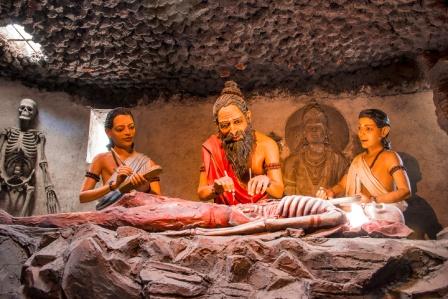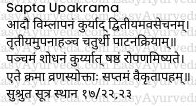Sushruta’s 7 Types of Treatments Sapta Upakrama
By Dr Raghuram Y.S. MD (Ay) & Dr Manasa, B.A.M.S
Sapta Upakramas are the treatments used in ancient days for surgical interventions and procedures especially for treatment of acute /chronic wounds, their complications and to prevent their relapse. Their utility can be extended in skillful ways to treat other systemic diseases also with changes in treatment designing.

Sapta Upakramas are 7 kinds of treatments which are explained in Sushruta Samhita, ‘Amapakvaishaniyam Adhyayam’ Sutra sthana 17th chapter, Verses 54. Sapta = seven, Upakrama = treatments.
Master Sushruta has just mentioned the names of these 7 kinds of treatment without explaining them in detail. The verse which highlights the names of these 7 specialized treatments is the last verse of this chapter. So we get a question, what might be the clinical or surgical utility of the procedures which are not detailed in the texts?
Read – Shashti Upakrama Meaning, Classification, Clinical Significance
Magnification of 7 Upakramas – Master Sushruta has just given a synopsis of these treatments in Sutra Sthana, a section of treatises wherein things need to be said in nutshell. He also had a magnified version of these 7 treatments and called it as ‘Shashti Upakrama’ i.e. ’60 kinds of treatments’. So precisely, Sushruta has hidden ‘60 precious treatment procedures’ within the core of 7 treatments only to present them in a magnified way in the later context. Sushruta has explained these 60 kinds of specialized treatments in the first chapter of Chikitsa Sthana section which mainly deals with treatment aspects of many diseases.
Read – Charaka Vrana Chikitsa – 25th Chapter – Wounds, Ulcers
Table of Contents
Sapta Upakrama
Master Sushruta has explained the chronology in which these 7 treatments should be administered. They are –
- Vimlapana
- Avasechana
- Upanaha
- Patana Kriya
- Shodhana
- Ropana
- Vaikrutapaha
Sanskrit Verses

Shashti Upakrama in Sapta Upakrama
Different kinds of treatments mentioned in shashti upakrama have been included under sapta upakrama. Interestingly the 60 treatments explained in chikitsa sthana are also mentioned in a chronology. The inclusions of fragments of 60 treatments under each treatment of sapta upakrama themselves define each of the 7 treatments and what, how and when these treatments shall be conducted. In either case the chronology shall be maintained. All treatments and included sub treatments are not needed in all cases of wound treatment. They are selective and conditional and apply to the stage of wound we are dealing with.
Read – 4 Types Of Swedana As Per Sushruta And Vagbhata
1. Vimlapana
Vimlapana means to soften or causing to wither / languish. From the list of 60 treatments the below mentioned 6 treatments are included under Vimlapana. They are used to make the wound soft.
| Sl No | Name of the Upakrama (treatment) | Meaning |
| 1 | Apatarpana | fasting |
| 2 | Alepa | application of medicinal pastes |
| 3 | Parisheka | showering of medicinal fluids |
| 4 | Abhyanga | oil massage |
| 5 | Sweda | fomentation or sudation |
| 6 | Vimlapana | gentle pressing / cleansing measures |
2. Avasechana
Avasechana means to expel the doshas. From the list of 60 treatments the below mentioned 4 treatments are included under Avasechana.
| Sl No | Name of the Upakrama (treatment) | Meaning |
| 1 | Visravana | drainage |
| 2 | Sneha | inducing oiliness |
| 3 | Vamana | therapeutic emesis |
| 4 | Virechana | therapeutic purgation |
3. Upanaha
Upanaha means applying a poultice. It is a kind of sudation therapy. From the list of 60 treatments the below mentioned 2 treatments are included under Upanaha.
| Sl No | Name of the Upakrama (treatment) | Meaning |
| 1 | Upanaha | poultices |
| 2 | Pachana | helping the pus to form properly so as to drain it out |
4. Patana Kriya
Patana means tearing, slipping, dividing or making incision. Kriya is the method in which this is conducted. From the list of 60 treatments the below mentioned 9 treatments are included under Patana Kriya.
| Sl No | Name of the Upakrama (treatment) | Meaning |
| 13 | Chedana | excision |
| 14 | Bhedana | incision |
| 15 | Darana | splitting / tearing |
| 16 | Lekhana | Scraping |
| 17 | Eshana | Probing |
| 18 | Aaharana | Extraction |
| 19 | Vyadhana | Puncturing |
| 20 | Vidravana | Liquefaction |
| 21 | Seevana | Suturing |
Read – Sushruta’s 8 Types Of Surgical Procedures – Astavidha Shastra Karma
5 & 6. Shodhana and Ropana
Shodhana means cleansing. Ropana means healing. From the list of 60 treatments the below mentioned 13 treatments are included under Shodhana and Ropana.
| Sl No | Name of the Upakrama (treatment) | Meaning |
| 1 | Sandhana | Unification, union of fractures |
| 2 | Peedana | Compression |
| 3 | Shonita sthapana | Checking the bleeding, enabling proper circulation |
| 4 | Nirvapana | Application and showering of cold potency medicines |
| 5 | Utkaarika | Application of warm semi-solid vata alleviating medicinal pastes to treat wound inflammation and necrosis of wounds |
| 6 | Kashaya | Administering herbal decoctions |
| 7 | Varti | Application / inserting suppositories |
| 8 | Kalka | Herbal Paste Application |
| 9 | Sarpi | Use of medicated ghee |
| 10 | Taila | Use of medicated oils |
| 11 | Rasakriya | Administration of semi-solid medicinal extracts |
| 12 | Avachurnana | Sprinkling of herbal powders |
| 13 | Vrana Dhupana | Fumigation of wounds |
Read – Injury, Wound care Ayurvedic Remedies, Medicines
7. Vaikrutapaha
Vaikrutapaha means removing the deformities or undesired changes which have occurred as complications or sequels of wounds. From the list of 60 treatments the below mentioned 26 treatments are included under Vaikrutapaha.
| Sl No | Name of the Upakrama (treatment) | Meaning |
| 1 | Utsadana | Elevation of wounds – treatment of wounds with some herbs to improve granulation tissue so as to raise the floor of the wound |
| 2 | Avasadana | Depression of wounds – removal of unhealthy, unnecessary, hyper-granulation tissue from floor of the wound which might delay healing of wounds |
| 3 | Mrudu Karma | Softening the edges of the wounds |
| 4 | Daruna Karma | Hardening the margins of the wounds (some wounds have less tensile strength so that the wound margin easily separate causing early dehiscence and wound healing delayed. To avoid long time wound healing, daruna karma is done) |
| 5 | Kshara Karma | Application of alkalis |
| 6 | Agni Karma | Fire cauterization |
| 7 | Krshna Karma | Inducing black color (hypo-pigmentation area made normal like surrounding tissue) |
| 8 | Pandu Karma | Inducing white color (hyper-pigmentation area made normal like surrounding tissue) |
| 9 | Pratisaarana | Tablets made up of rough powder of medicinal herbs is rubbed on soft shiny skin (after wound healing) so as to make the skin surface rough, just like the normal skin |
| 10 | Roma Sanjanana | Treatments and medicines (measures) enabling growth of hairs |
| 11 | Loma Apaharana | Treatments and medicines (measures) enabling removal of unnecessary hairs |
| 12 | Vasti Karma | Medicinal Enemas |
| 13 | Uttara Vasti Karma | Enemas given through urinary and genital passages |
| 14 | Bandha | Bandages |
| 15 | Patra Daana | Covering the wounds with leaves |
| 16 | Krimighna | Disinfectants |
| 17 | Brmhana | Bulk promoting and strengthening treatments |
| 18 | Vishagna | Anti-toxins, treatments and medicines which nullify or neutralize the effect of poisons and toxins |
| 19 | Shiro virechana | Nasal instillation of medicines |
| 20 | Nasya | Nasal instillation of medication / Errhines |
| 21 | Kavala dharana | Rinsing of mouth with medicinal liquids |
| 22 | Dhooma | Fumigation |
| 23 | Madhu sarpi | Administration of honey and ghee |
| 24 | Yantra | Instrumentation |
| 25 | Aahara | Dietetic regimen |
| 26 | Rakshaa vidhana | Sterilization (the surgical ward, instruments etc should be sterilized by fumigating with Guggulu (Commiphora mukul) etc herbs and Mantra uccharana (uttering or reciting holy hymns) to kill the small pathogenic organisms) |
Click to Consult Dr Raghuram Y.S. MD (Ayu)









